12th International Conference on Computer System Design and Operation in the Railway and other Transit Systems
31 August - 2 September 2010
Beijing, China
Overview
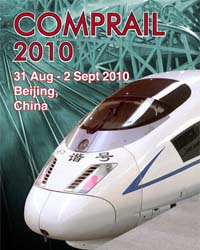 The 12th International Conference on Computer System Design and Operation in Railways and other Transit Systems (COMPRAIL 2010) has recently taken place in Beijing Jiaotong University. The conference series has been the most successful in its field since it started in 1987.
The 12th International Conference on Computer System Design and Operation in Railways and other Transit Systems (COMPRAIL 2010) has recently taken place in Beijing Jiaotong University. The conference series has been the most successful in its field since it started in 1987.
The COMPRAIL 2010 conference reflected the new achievements and applications of advanced technologies in management, design and operation of passenger and freight transit systems. Rail transport has many advantages over other modalities in terms of capacity, punctuality, weather resistance, savings in fuel and land and fairly low pollution. It is a low carbon emission transport model and ought to be the backbone of any regional and city comprehensive travel system.
Safety is one of the central topics of rail systems, together with efficiency. Computer based technologies have always played an important role in the safety and efficiency of transit systems; the more so as many countries have recently become interested in developing high speed railways. This topic was discussed during the conference and it is expected that it will become more importance in future COMPRAIL meetings. The above were just some of the topics discussed during the conference, contents of which are described in more detail below.
Opening Addresses
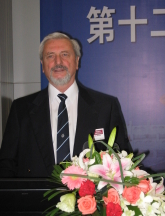 The meeting was opened by Professor Carlos A. Brebbia, Director of Wessex Institute of Technology and co-chairman of the conference in conjunction with Professor Bin Ning, President of Beijing Jiaotong University. Professor Brebbia welcomed the delegates as follows;
The meeting was opened by Professor Carlos A. Brebbia, Director of Wessex Institute of Technology and co-chairman of the conference in conjunction with Professor Bin Ning, President of Beijing Jiaotong University. Professor Brebbia welcomed the delegates as follows;
“It is a great pleasure to open this conference in the name of Wessex Institute of Technology. This is the twelfth COMPRAIL in the series, a meeting that has been held in many locations around the world.”
“This time the conference is associated with the renown Beijing Jiaotong University (BJTU), internationally recognised in the field of railway research. It was time that the conference was held in Asia as it is timely for it to be convened in China where so many new developments in railway engineering are taking place.”
“Wessex Institute of Technology (WIT) is dedicated to the transfer of knowledge at an international level and this is in great part achieved through our programme of conferences, seminars and courses as well as the associated publications.”
“WIT is also dedicated to serving industry and we have set up a special industrial research and development unit (BEASY) which continues to develop boundary element computational research based on a method for which our Institute is renown throughout the world. The division has carried out work on damage-related railway infrastructure problems. These industry focused activities are integral to the harmonious development of our international research and they help to guide our strategy."
“In addition to the meeting programme, WIT has developed research links with many institutions around the world including this prestigious university. They are the basis on which to plan a variety of activities including postgraduate courses, PhD training and joint research projects. Most of our research has - directly and indirectly - originated through contacts made at conferences such as this”.
“The success of our meetings programme as well as other WIT activities can be judged by its continuous development and evolution. This is reflected in the contents of the conference book as well as in the diversity of countries represented at COMPRAIL 2010.”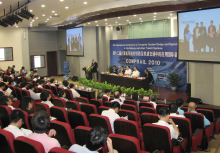 “The books and Journals produced by our Institute are published by WIT Press. They are highly specialized and very successful throughout the world. Our objective is to improve the quality of these publications, as can be judged by the standards of this conference’s proceedings.”
“The books and Journals produced by our Institute are published by WIT Press. They are highly specialized and very successful throughout the world. Our objective is to improve the quality of these publications, as can be judged by the standards of this conference’s proceedings.”
“The publishing industry is undertaking a milestone transformation with the increasing importance of digitized books and Journals. WIT Press is responding to this by providing all its publications – such as these conference proceedings as well as other books and Journals - in digital as well as paper format.”
Carlos followed by thanking Beijing Jiaotong University and in particular Professor Bin Ning, its President, for hosting COMPRAIL 2010 as well as all members of the International Scientific Advisory Committee and other colleagues who helped to review the papers and most specially to all authors whose excellent contributions made the conference so successful.
Professor Brebbia concluded by congratulating Professor Bin Ning and his team for the excellent organisation of the meeting which was the fruit of many months work. He thought it appropriate to quote Confucius (550-478 BC) who said “In all things, success depends on your previous preparation and without such preparation, there is sure to be failure.”
Professor Bin Ning, then welcomed the delegates in the name of Beijing Jiaotong University pointing out the importance of railways in modern society as a mechanism to achieve environmental targets as well as being a rapid and efficient transportation mode.
Professor Ning mentioned that he had attended all COMPRAIL conferences following the first meeting held in Frankfurt and very much wanted to host COMPRAIL 2010. He then described some of the research and training activities taking place at Beijing Jiaotong University and in particular the fact that the university hosts the State Key Laboratory of Rail Traffic Control and Safety which is supported by the Ministry of Railways.
Professor Ning ended by thanking all the delegates for their presence at the conference and hoping that this will lead to closer contacts between all of them and in particular with BJTU.
Keynote Address by Mr Shuguang Zhang
The Keynote Address at the conference was given by Mr Shuguang Zhang, Deputy Chief Engineer at the Ministry of Railways, Republic of China. His address was entitled ‘The technical innovations of China High Speed Railways’.
China, Mr Zhang explained, is now building a large railway network and it is important in this context to appreciate the current conditions of the country and how large China is. Railways are needed spanning long distances to support the distribution of commodities and industries, the latter located mainly in the east of the country. The urbanisation of China has also added urgency to railways requirements; its rapid development requires serving medium and comparatively small cities as well as the major metropolises. The development of large city clusters, a modality stronger in China than in other countries, has added urgency to the transportation problems. These challenges can not be met by air and road transport, and the development of railways is the only available alternative and requires building substantial high speed lines.
By 2020, China will have built 18,000km of high speed railways while continuing to carry out further extensions to the existing lines. At present there exists 6,000km of high speed railway lines, serving 100 million people. The whole technological infrastructure for this initiative will be very large and the planning needs to take into consideration future as well as present maintenance costs.
The technology required for this plan is all computer driven and posses colossal challenges in the development of power supply and infrastructure technology systems, particularly as it is envisaged in the future to increase further the speed of the trains. The aim is reach 380km/hour on lines such as Beijing to Shanghai, a traject that justifies such speeds. Associated technologies relating to topics such as safety and disaster prevention will require further development.
Mr Zhang then referred to other countries contributing significant work in the field of high speed trains, namely Japan, Germany and France.
Research continues to reach speeds of 500km/hour in the future which will require large amounts of support. New train generations will need to be highly intelligent, with automated systems for self-diagnosis and the regional fault corrections.
Mr Zhang concluded by saying that the research requirements of railways ought to ensure the success of many COMPRAIL conferences in the future.
Invited Presentations
The conference sessions consisted of a substantial number of excellent papers and a few invited presentations as listed below;
‘How regular is a regular-interval timetable? From theory to application’
By Panos Tzieropoulos, Federal University of Lausanne, Switzerland
‘Port Hinterland traffic: modern planning IT methods’
By Alfons Radtke, A IVE mbH consulting company for Traffic and Railway Engineering, Germany
‘Design, development, application, safety assessment and simulation of the railway signaling system’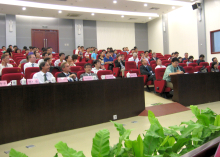 By Bin Ning, Beijing Jiaotong University, China
By Bin Ning, Beijing Jiaotong University, China
‘How the punctuality of the Shinkansen has been achieved’
By Norio Tomii, Chiba Institute of Technology, Japan
‘Rescue operations on dedicated high speed railway lines’
By Kyo Takagi, Tokushima University, Japan
‘CBTC test simulation bench’
By Jose Manuel Mera, CITEF (Railway Technical Research Centre), Spain
Conference Topics
The conference papers were grouped in a series of sessions with the following headings;
- Advanced train control
- Communications
- Computer techniques
- Planning
- Maglev and high speed railways
- Metro and other transit systems
- Energy supply and consumption
- Dynamics and wheel/rail interface
- Operations quality
- Monitoring and Maintenance
- Safety and Security
- Timetable Planning
Special Session
There was a special session organized by Professor Norio Tomii from Chiba Institute of Technology, Japan, comprising, in addition to his invited presentation, the following other papers entitled;
- ‘Linkage of a conventional line dispatch system with the Shinkansen dispatch system’
- ‘Train scheduling of Shinkansen and relationship to reliable train operation’
- ‘Rescue operations on dedicated high speed railway lines’
- ‘Track measurement by Kyushu Shinkansen cars in commercial service’
- ‘Development of a high-speed overhead contact line measurement device for the Kyushu Shinkansen’
- ‘The analysis of train reliability for the Taiwan High Speed Rail’
Technical Visits
During the conference the participants were given the opportunity to visit the State Key Laboratory of Rail Traffic Control and Safety located at Beijing Jiaotong University, where they had occasion to see some of the research being undertaken there on behalf of the Ministry of Railways.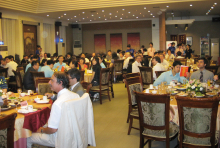 The substantial number of participants led to the need to have parallel sessions but ample time was allocated for the delegates to meet outside the conference rooms. This was achieved by a series of social functions. In addition to refreshment breaks the conference organizers offered complementary lunches and the Beijing Jiaotong University hosted a conference dinner to which all delegates and partners were invited.
The substantial number of participants led to the need to have parallel sessions but ample time was allocated for the delegates to meet outside the conference rooms. This was achieved by a series of social functions. In addition to refreshment breaks the conference organizers offered complementary lunches and the Beijing Jiaotong University hosted a conference dinner to which all delegates and partners were invited.
The first technical visit consisted of riding the high speed train leaving Beijing South Railway Station to Tianjin, where delegates were shown the new station, returning afterwards to the University for dinner.
The second excursion took place the day after the conference. Delegates were driven to the Great Wall of China. This renown symbol of China started being built in the 5th century BC and was extended and maintained until the 16th century  when it started to deteriorate. The wall was to protect the borders of the Empire against different invaders. The wall stretched for nearly 9,000km; 6,000km of which are actual wall and the rest are natural defenses. It is without doubt one the most impressive sights on earth.
when it started to deteriorate. The wall was to protect the borders of the Empire against different invaders. The wall stretched for nearly 9,000km; 6,000km of which are actual wall and the rest are natural defenses. It is without doubt one the most impressive sights on earth.
After the visit to the wall, the delegates were taken to the China Railway Museum which contains an impressive collection representative of the railway history of the country. The exhibition hall covers 16,500m2 and contains 40 locomotives, amongst them the earliest steam engines as well as Mao Zedong train and a variety of railway carriages and wagons. A well-designed exhibition room describes the development of railways in China.
International Scientific Advisory Committee
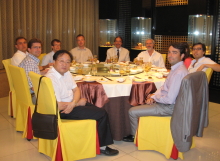
The International Scientific Advisory Committee met over dinner at a renowned restaurant to discuss the meeting and plan the next conference which will take place in 2012. Several locations were put forward, as well as a range of topics to be included in the new Call for Papers and the list of colleagues to be invited to join the committee.
The success of COMPRAIL 2010 will ensure that the series continues to report the latest research of interest to industry as well as academics.
Publication of Papers
The proceedings of COMPRAIL XII, 1024pp (Print ISBN: 978-1-84564-468-0; Online ISSN: 1743-3509) are available from WIT Press priced at £389/US$778/€545. Orders can be placed online at www.witpress.com or by email:
Papers from the conference are hosted online in the WIT eLibrary as Volume 114 of WIT Transactions on the Built Environment (ISSN: 1743-3541). For more details visit the WIT eLibrary at http://library.witpress.com


 Wessex Institute
Wessex Institute